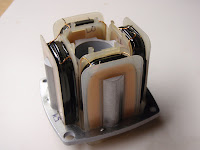SYSTEM
The two M2 2M7 antennas feed directly into an Advanced Receiver Research SP144VDG GasFET preamplifier (24dB gain, NF=0.5dB) on the mast, which then sends the RX signal down 75 feet of RG-8/U coax to a 50-ohm hybrid splitter/combiner in the shack. One port of the hybrid feeds the FunCube Dongle Pro Plus (FCDPP) software defined radio (SDR), the other side feeds the Yaesu FT-817ND conventional radio with intalled TXCO. The FCDPP sends signal to Linrad which sends signal to MAP65 software. The FT817ND sends signal through the computer's soundcard to WSJT9 software.
ANALOG RADIO
The Yaesu FT-817ND seems fairly well optimized for weak-signal VHF detection right out of the box. I use settings of Noise Blanker (NB) = ON, Automatic Gain Control (AGC) = OFF, and RF Gain set to a reading of about S2 on the S-meter (equivalent to roughly a 2 to 3 dB reduction in RF gain from max). The interface box between the FT-817ND and the computer's microphone input jack is adjusted so that Windows sees about 2 "bars" of signal on the microphone levels. I arrived at these settings by empirically watching weak signals on the WSJT9 waterfall display and optimizing for best visual signals. It's subtle -- there's not much difference between out-of-box defaults (AGC On, RF Gain Max) and these settings, both seem to work well, but in my location (suburban RF noise) having AGC off seems to allow the WSJT9 software to see fainter traces through the noise.
SOFTWARE-DEFINED RADIO
The FunCube Dongle Pro + is a completely different SDR than the original FunCube Dongle or Funcube Dongle Pro. It contains an entirely different tuner chip, it has an embedded TXCO, and it has a front-end SAW filter for the 2m band. Published settings for the FCD/FCDP with Linrad and MAP65 won't work directly with the FCDPP because the control interface is different. Rather than having variable control of the LNA and Mixer gains, the FCDPP has two settings for the LNA (ON and OFF) and two settings for the Mixer (LOW and HIGH). The ExtIO package that I'm using (from HDSDR) has LNA ON and Mixer HIGH by default. Comparing different settings on the FCDPP and watching the waterfall display for weak traces, it seems that the combination of LNA ON and Mixer HIGH (=default) gives the best visual appearance of faint traces. Turning the LNA off or the Mixer to low causes very faint traces to disappear into the background noise.
LINRAD SETTINGS
Linrad samples the FunCube Dongle Pro Plus at 96000 Hz. I found that I needed to reduce the "front-end gain" of of Linrad in order to have the relatively high signal levels from the FCDPP not saturate the Linrad waterfall (settings above with Linrad defaults can lead to more than 40dB signals). By reducing Linrad's FFT1 Amplitude value from the default of 1000 (or 500) to 100, the signals from the FCDPP with antennas pointed into a quiet sky are a more reasonable +22dB or so. At present, I have Linrad also set with AFC disabled, Strong Signal Removal "1" (=off), MAP65 Attenuation -15dB, and the "dumb" noise blanker (NB) set to blank about 5% of the incoming signals.
MAP65 SETTINGS
Linrad feeds the I/Q data stream to MAP65 via port 50004 at 96000 Hz, and with these settings MAP65 has a reasonable signal input level (around 23dB cold sky). Turning the mast-mounted preamplifier off reduces the noise level by around 22dB. Interestingly, before I turned Linrad's FFT1 front end gain down, the high incoming signals (about 43dB on MAP65) resulted in visually nice signals but almost no decodes! Joe K1JT recommends to keep MAP65 input signals between 20dB and 30dB, and this seems to be very important.
ALTERNATE CONFIGURATION
(Side note: I've also used the FCDPP setting LNA=ON Mixer=LOW with Linrad FFT1 Attenuation 500, and while this achieves a similar end-result in the dB value sent to MAP65 (about 20dB cold sky), traces aren't as visually prominent, and decodes are a little spotty compared to WSJT9 with the FT817ND. Moreover, in this other configuration, turning the mast-mounted preamplifer off reduces MAP65 noise by only 10-12 dB, which allows relatively more system noise to enter the noise factor equation.)
COMPARISONS BETWEEN SYSTEMS
Initial direct comparison of incoming EME signals indicates that the two systems (WSJT9/FT817ND and MAP65/FunCube Dongle Pro+) are pretty much identical in terms of sensitivity. Over 26 full messages decoded, the two systems were very close in reported S/N dB values: MAP65 had, on average, a 0.65 dB worse S/N reading, with a standard deviation of just over 1.0. For 9 shorthand messages, MAP65 had an average of 2.50 dB better S/N reading, with a SD of 1.5. Interestingly, the MAP65 system decoded 9 messages that WSJT9 did not decode, as opposed to only 2 messages that WSJT9 decoded that MAP65 missed. Most of these missed by the WSJT9 system were shorthand messages.
SUMMARY
Overall, it seems that the peformance of the MAP65 + Linrad + FunCube Dongle Pro Plus system is virtually identical to the WSJT9 + FT817ND system. The advantage of the MAP65 system, of course, is that the FunCube Dongle Pro+ sees the entire EME sub-band at once, and MAP65 can automatically decode messages found anywhere across the band! This seems to be a real help in small-station EME, since the software can automatically find stations that are strong enough for my antennas to hear.



.jpg)








































































